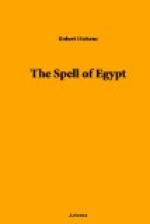I sat very still. The light was fading; all the yellow was fading, too, from the columns and the temple walls. I stayed till it was dark; and with the dark the old gods seemed to resume their interrupted sway. And surely they, too, called to prayer. For do not these ruins of old Egypt, like the muezzin upon the minaret, like the angelus bell in the church tower, call one to prayer in the night? So wonderful are they under stars and moon that they stir the fleshly and the worldly desires that lie like drifted leaves about the reverence and the aspiration that are the hidden core of the heart. And it is released from its burden; and it awakes and prays.
Amun-Ra, Mut, and Khuns, the king of the gods, his wife, mother of gods, and the moon god, were the Theban triad to whom the holy buildings of Thebes on the two banks of the Nile were dedicated; and this temple of Luxor, the “House of Amun in the Southern Apt,” was built fifteen hundred years before Christ by Amenhotep III. Rameses II., that vehement builder, added to it immensely. One walks among his traces when one walks in Luxor. And here, as at Denderah, Christians have let loose the fury that should have had no place in their religion. Churches for their worship they made in different parts of the temple, and when they were not praying, they broke in pieces statues, defaced bas-reliefs, and smashed up shrines with a vigor quite as great as that displayed in preservation by Christians of to-day. Now time has called a truce. Safe are the statues that are left. And day by day two great religions, almost as if in happy brotherly love, send forth their summons by the temple walls. And just beyond those walls, upon the hill, there is a Coptic church. Peace reigns in happy Luxor. The lion lies down with the lamb, and the child, if it will, may harmlessly put its hand into the cockatrice’s den.
Perhaps because it is so surrounded, so haunted by life and familiar things, because the pigeons fly about it, the buffalo stares into it, the goats stir up the dust beside its columns, the twittering voices of women make a music near its courts, many people pay little heed to this great temple, gain but a small impression from it. It decorates the bank of the Nile. You can see it from the dahabiyehs. For many that is enough. Yet the temple is a noble one, and, for me, it gains a definite attraction all its own from the busy life about it, the cheerful hum and stir. And if you want fully to realize its dignity, you can always visit it by night. Then the cries from the village are hushed. The houses show no lights. Only the voices from the Nile steal up to the obelisk of Rameses, to the pylon from which the flags of Thebes once flew on festal days, to the shrine of Alexander the Great, with its vultures and its stars, and to the red granite statues of Rameses and his wives.




